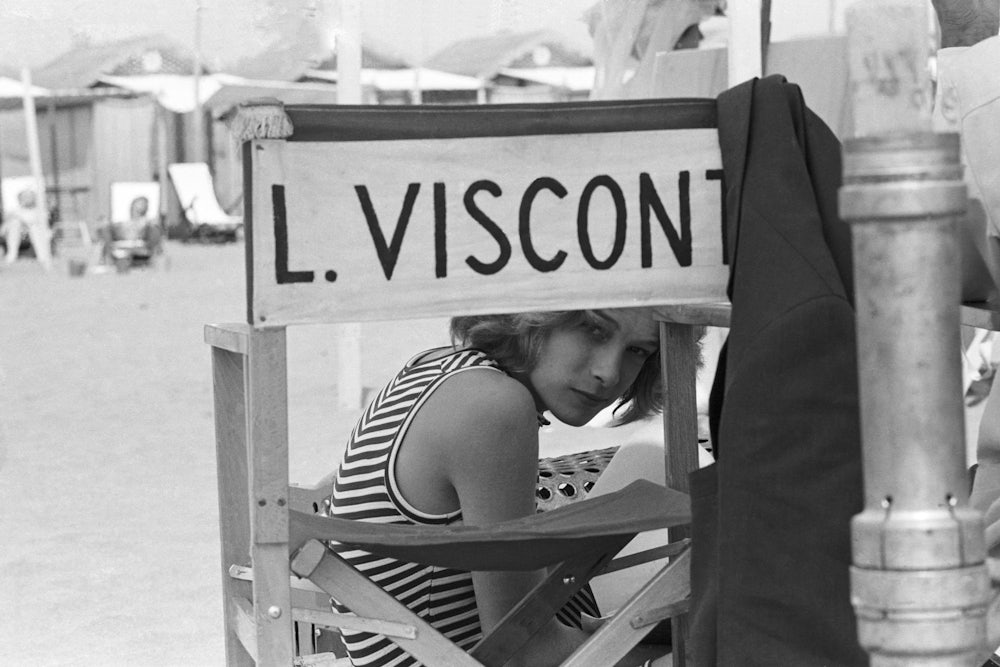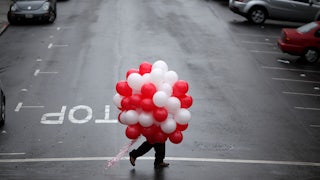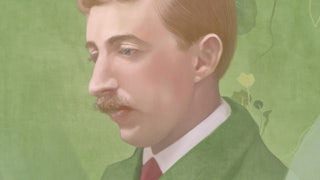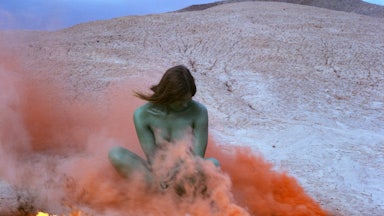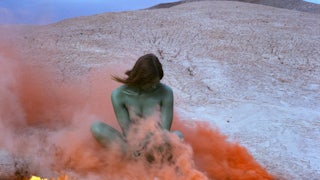Though you may not know the name Björn Andrésen, you may well recall his face. In Ari Aster’s 2019 film, Midsommar, he played the elderly man with long, gray hair who participates in the Harga community’s terrifying clifftop “Ättestupa” ritual. This scene, which marks the moment that Midsommar turns unbearably gory, is elevated by Andrésen’s elegance; his few lines are mostly hummed, but with his rangy El Greco limbs and the way his hair floats upward when he falls, Andrésen brings to Midsommar a quality one can only call grace.
Now 66, Andrésen remains best known for the natural beauty he possessed as an adolescent boy. In a new documentary, The Most Beautiful Boy in the World, directors Kristina Lindström and Kristian Petri tell the story of his overnight transformation from lonely teenager into screen icon in 1971, when director Luchino Visconti cast him as the exemplar of adolescent male beauty in his movie Death in Venice. The film framed him as the object of adult desire and offered him up for consumption in the boundaryless, taboo-busting entertainment market of 1971—an experience that had devastating effects on Andrésen’s self-esteem. The Most Beautiful Boy in the World is a rare exploration of the consequences of objectification on the psyche of a young male actor, and an exorcism of the ghosts that have followed him.
Luchino Visconti, who also conducted opera, was a patriarch of Italian cinema whose 1943 film Ossessione is usually cited as the first Italian neorealist film. He was 64—two years younger than Andrésen is now—when he went out looking for the leading boy for his upcoming adaptation of Thomas Mann’s Death in Venice. Visconti had by 1970 renounced the austerity that characterized his youthful works and begun making films that delight the senses. In Senso (1954), The Leopard (1963), and The Damned (1969), European aristocrats disintegrate in ways both nihilistic and highly picturesque, all filmed in color, their sets adorned with velvet, silk, palm fronds, and mustaches.
Death in Venice would be the culmination of this tendency in later Visconti. Thomas Mann’s original 1912 novella follows an intellectual named Gustave von Aschenbach, who goes on holiday in Venice to rest, only to spend his final days in stupefied love with “a long-haired boy of about fourteen” named Tadzio, whose beauty provokes him to a series of progressively clichéd statements on the nature of beauty and death. He pretends to himself for most of the story that his love for the boy is coldly, classically appreciative; he sees Tadzio as an artwork with “the head of Eros, with the yellowish bloom of Parian marble, with fine serious brows, and dusky clustering ringlets standing out in soft plenteousness over temples and ears.” The story ends with Aschenbach contracting cholera and expiring in a deck chair, reaching for his beloved, all his dignity fled.
In the late 1960s, it seemed appropriate to Visconti to publicize his future movie by seeking his Tadzio in public. The casting process was a circus, and directors Lindström and Petri have built the documentary around a central archive of footage showing the day the famous director encountered Andrésen at a Stockholm audition. Earlier, we saw Visconti walk through what appeared to be a classroom, looking at boys’ faces and making comments about their eyes, or hair. Then 15-year-old Björn Andrésen walks into his wood-paneled casting room. He looks nervous, eager to please; initially stunned to be asked to remove his shirt, then—and this bit hurts to watch—smiling shyly, as if pleased, for the first time, at the attention being paid to him. He is extremely beautiful, and Visconti notes that his eyes are “gray, the color of water,” just as Thomas Mann specified.
“The boy was exquisitely beautiful. He is fragile. And that is beautiful … on film,” says Margareta Krantz, the Swedish casting director for Death in Venice, in the documentary. “You have to be very careful with such children.” But nobody was careful with Andrésen, who had no parental figures in his life, only a grandmother who was much more excited than he was about his new life as a movie star; he remembers that she brought her own Super 8 camera to Venice and insisted that he accept the offer of a press trip to Japan.
There, on set in Japan for An-An magazine in 1971, Andrésen recalls taking pills offered to him by handlers. His celebrity snowballed in that country, and he released two pop singles. His look in the movie inspired a huge wave of fascination with sailor tops and androgynous beauty, and the documentary describes him as the first Western “idol” in Japanese popular culture. In a twist of art history that the learned Gustave von Aschenbach would no doubt have appreciated, the legendary artist Riyoko Ikeda appears in The Most Beautiful Boy in the World, to describe how Andrésen inspired her historical manga and inspired the aesthetic concept of the bishōnen, the doomed hero caught at the peak of his youthful beauty. “There’s a kind of sadness in his face,” Ikeda says. “I always wondered if our interest in his face hurt him.”
It did. Looking back now, Andrésen describes how starring in Death in Venice unleashed what felt like a “swarm of bats” around him, in the form of people who were fascinated by his physical appearance but uninterested in him. When he moved to Paris, later in the 1970s, he knew that the older gentlemen of his acquaintance didn’t pay his rent out of the goodness of their hearts; it was because of how he looked. He never seemed to have any money of his own, he recalls, and yet somebody was always around to pay his way. He doesn’t remember everything about his inebriated nights out, he says.
The Most Beautiful Boy in the World is a window on the confounding sexual mores of the 1970s, when popular culture eroticized increasingly young performers. In the 1978 film Pretty Baby, Louis Malle cast a 12-year-old Brooke Shields as a child whose virginity is sold at auction. In music, songs about “little girls” and their beauty were common—in 1973, for example, Ringo Starr released a cover of the Johnny Burnett song, “You’re Sixteen,” whose refrain runs, “You’re sixteen, you’re beautiful, and you’re mine.” This mainstream permissiveness toward the sexualization of minors had its counterpart in queer theory. In a 1978 essay, “Sexual Politics, the New Right and the Sexual Fringe,” feminist author Gayle Rubin wrote, “We must not reject all sexual contact between adults and young people as inherently oppressive.” Where the 1960s was a time of radical opening for sexual politics, in the 1970s artists interested in sexuality roamed the furthest edges of that newly opened-up space, testing its boundaries.
Visconti was one such artist, and Death in Venice one such journey to the edge of the permissible. There’s no direct touching in the movie, but the camera’s gaze on Tadzio is unmistakably erotic. Without the support of a family unit, Andrésen was not well equipped to deal with the onslaught of superficial and sexual attention that the film brought, and his life post–Death in Venice spiraled out of control. Confused about his own sexuality, and unsure how to gauge the motivations of the new people he met, he pursued the glitzier side of life until it overwhelmed him. He lost a son during his chaotic middle years and became unable to face the responsibility of caring for his surviving daughter. Despite moderate success as an actor, and his influence on a genre of Japanese art with mushrooming global appeal, he ended up living alone in an unkempt apartment; at the documentary’s start we see him fend off his landlord’s attempt at evicting him for not maintaining it.
The film ends on a hopeful note, with father and daughter reuniting. Together, they mourn the loss of their family member and what their relationship could have been like. Now that we see children and sexuality so differently, says his daughter, the footage of her father’s discovery by the famous director is impossibly sad to watch. If he’d never been cast in that film, she wonders aloud, who might Björn Andrésen have become?
Moody, unhurried, and colored largely in a palette of blues, the documentary approaches Andrésen’s trauma tenderly and without rushing, to narrate his life roughly in reverse. In a note of intention included with press materials, the directors write that Andrésen’s is “a story with many layers, a box within a box within a box.” Opening up closed things is the chief theme of Midsommar, too: At the heart of the movie is protagonist Dani’s grief over losing her family members and the lack of socially acceptable venues available to her for expressing it. When Andrésen as Dan falls from a great height, he offers Dani the chance to witness death as part of a community for the first time. Although it’s painful, it is the beginning of a healing transformation for her. Like Dani, Andrésen has spent a long time without the language to express what he went through. The Most Beautiful Boy in the World explores and honors that trauma in equal measure, and documents a troubling moment in the history of sexuality in popular culture.
